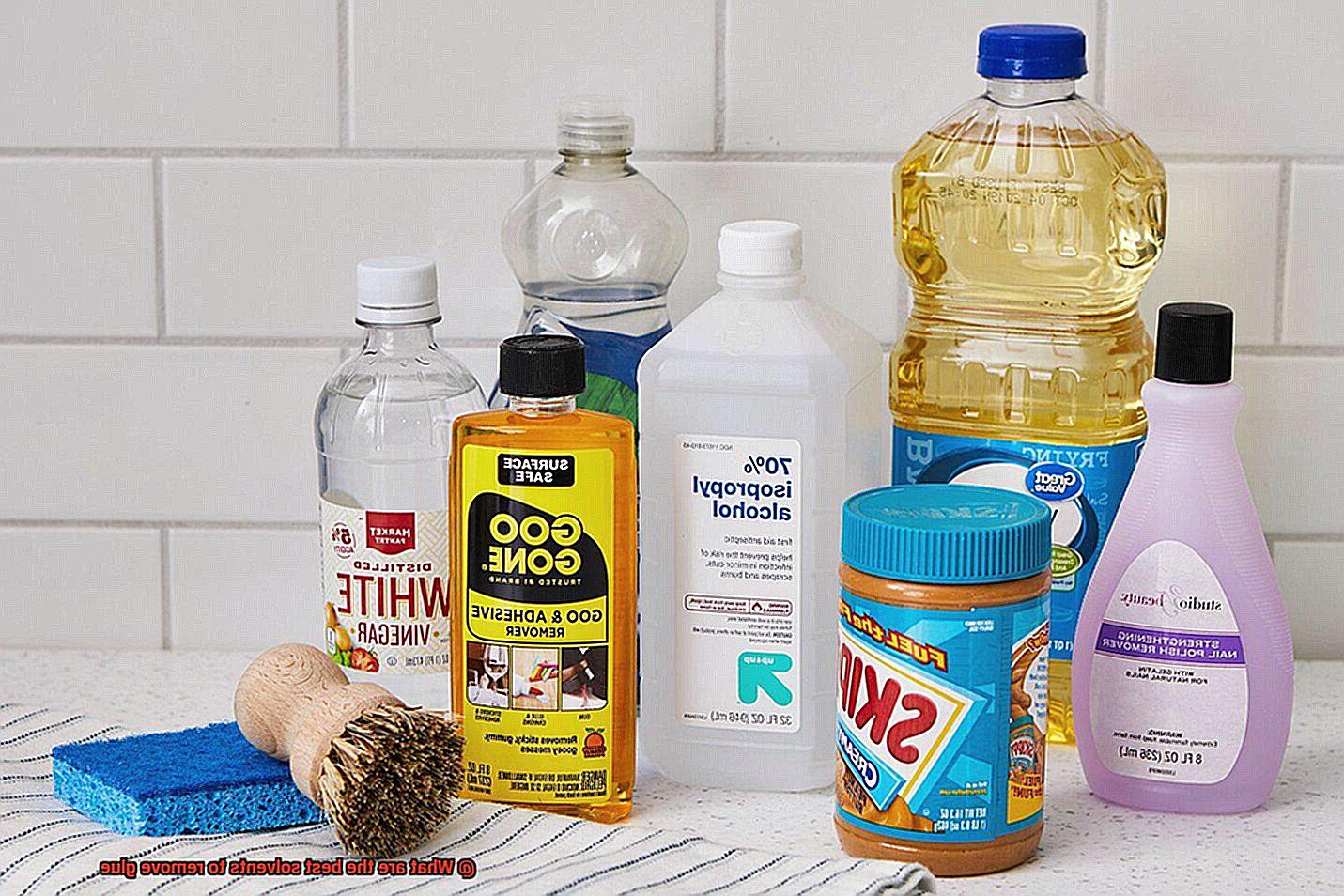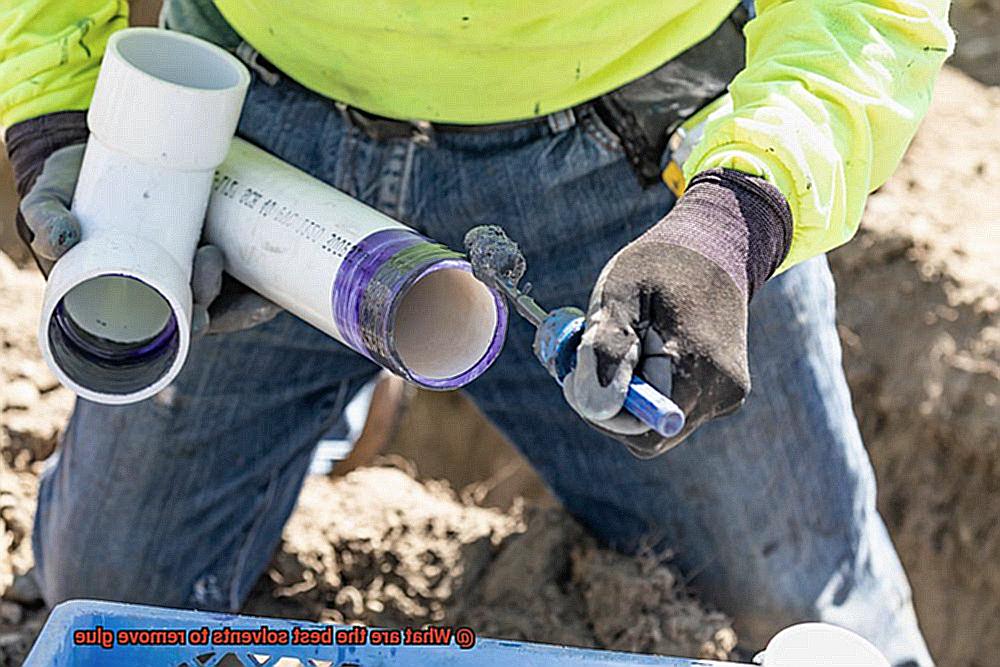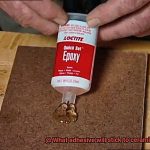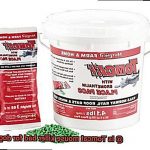It’s like that clingy friend who just won’t take a hint and leave. We’ve all been there, struggling to remove stubborn glue residue from our DIY projects or battling with packaging that seems sealed shut with industrial-strength adhesive. But fear not, my friend. In this guide, we’re going to spill the beans on the absolute best solvents that will make even the toughest glues surrender.
Whether you’re an arts and crafts enthusiast, a DIY guru, or just someone who can’t stand sticky situations (literally), finding the right solvent can be a game-changer in your quest for glue removal domination. So get ready to bid farewell to those pesky adhesive messes as we unveil the secret weapons against their tenacious grip.
Join us on this journey into the world of solvents as we uncover their superpowers in dissolving and loosening adhesive bonds. With our expert insights and passion for problem-solving, we’ll arm you with all the knowledge you need to conquer any glue-related challenge that comes your way.
From everyday household items to specialized products, we’ll explore both tried-and-true solvents and hidden gems you may have never heard of before. We’ll shed light on their unique properties and effectiveness in removing different types of glue. Prepare to be amazed as we reveal fascinating details about these solvents’ origins and even their unexpected uses beyond just getting rid of sticky stuff.
So whether you accidentally spilled glue on your favorite pair of jeans, need to banish sticky residue from your belongings, or want to give new life to an old item by removing excess adhesive, this guide is your ultimate resource. Get ready for an adventure through the world of solvents that will have you tackling any glue-related dilemma like a seasoned pro.
Stay tuned as we embark on this remarkable journey, sharing the best techniques, tips, and tricks to conquer glue’s stubborn grip. Let’s say goodbye to sticking nuisances and restore the beauty and functionality of our belongings with the power of the best solvents on the market. Get ready to become a glue-removing hero.
What is Glue?
Contents
- 1 What is Glue?
- 2 Types of Glue
- 3 The Benefits and Drawbacks of Using Solvents to Remove Glue
- 4 Acetone: Pros and Cons
- 5 Isopropyl Alcohol: Pros and Cons
- 6 White Vinegar: Pros and Cons
- 7 Vegetable Oil: Pros and Cons
- 8 Citrus-Based Solvents: Pros and Cons
- 9 Goo Gone: Pros and Cons
- 10 Warm Soapy Water: Pros and Cons
- 11 Conclusion
Glue, a remarkable adhesive substance, has held civilizations together for centuries. From crafting to construction, glue plays an essential role in bonding materials. In this comprehensive guide, we will explore the intricacies of glue, its various types, applications, and effective removal methods. Join us on this journey as we uncover the secrets of this extraordinary bonding agent.
Understanding Glue:
Glue is a versatile adhesive substance that comes in liquid or semi-liquid form. It possesses the remarkable ability to fill gaps, irregularities, and microscopic pores between surfaces, creating a strong molecular attraction as it dries. This invisible force binds materials together securely.
Types of Glue:
- PVA Glue: Perfect for general-purpose bonding, PVA glue is water-based, non-toxic, and dries clear. Whether it’s arts and crafts or school assignments, PVA glue is a reliable choice.
- Super Glue: Known as cyanoacrylate adhesive, super glue forms an instantaneous and incredibly strong bond. This adhesive is ideal for plastics, metal, rubber, and ceramics due to its rapid-setting properties.
- Epoxy Glue: Composed of resin and hardener components mixed before use, epoxy glue offers exceptional strength and durability. It is widely used in construction, automotive repairs, and industrial applications.
- Hot Glue: Applied using a hot glue gun, this adhesive melts at high temperatures and solidifies upon cooling. Its versatility makes it a popular choice for crafts and temporary bonding.
- Construction Adhesive: Engineered for heavy-duty bonding purposes, construction adhesive stands up to water and temperature changes. It is commonly used in building materials like wood, concrete, and metals.
Removing Glue:
When it comes to removing glue residue, different solvents can be employed based on the type of glue and the surface it adheres to. Here are some effective options:
- Acetone: A highly effective but flammable solvent, acetone is perfect for removing glue from glass, metal, and certain plastics.
- Isopropyl Alcohol: This safe and versatile solvent works well on many surfaces, although it may not be as effective on strong adhesives.
- White Vinegar: As a mild acid, white vinegar dissolves glue on wood, ceramic, and fabric surfaces without causing damage.
- Vegetable Oil: This natural solvent breaks down glue properties and is safe to use on most surfaces, although it may leave an oily residue.
- Citrus-based Solvents: Orange or lemon oil-based solvents effectively dissolve glue with a pleasant scent.
- Goo Gone: A commercial adhesive remover, Goo Gone contains solvents that break down glue residues without harming various surfaces.
- Warm Soapy Water: For water-based glues, soaking the affected area in warm soapy water combined with gentle scrubbing can effectively remove the adhesive.
Types of Glue
Glue, a magical substance that binds things together, comes in various forms with their own unique powers. In this article, we will delve into the fascinating world of glue, discovering its diverse types and learning how to effectively remove them when accidents happen.
PVA Glue – The Versatile Superhero:
PVA glue, also known as white glue, possesses the versatility of a superhero. It is perfect for all kinds of crafts, from constructing paper mache volcanoes to creating stunning collages. As a water-based adhesive, cleaning up spills is as simple as using a little water. However, beware. Once it dries, removing it becomes a bit trickier.
Super Glue – The Speedy Fixer:
Super glue is the flash of the glue world, working at lightning speed. It is ideal for repairing broken toys or bonding tiny objects like action figure capes. However, be cautious not to get it on your fingers. Removing super glue requires the assistance of a special solvent called acetone or nail polish remover. Remember to seek adult help when using these substances.
Epoxy Glue – The Unyielding Bond:
Epoxy glue boasts unyielding strength, making it perfect for demanding tasks such as mending shattered vases or joining metal pieces. Removing epoxy glue can be quite a challenge; you might need to employ specific solvents like acetone or paint thinner to dissolve its formidable grip.
Hot Glue – The Crafty Sidekick:
Hot glue serves as the trusty sidekick for crafters everywhere. It excels at adhering fabric, plastic, and even wood together. However, exercise caution as it can reach scorching temperatures. To safely remove hot glue, apply heat using a hairdryer to soften it and then gently peel or scrape it away.
Wood Glue – The Carpenter’s Best Companion:
Wood glue, a loyal friend to carpenters, specializes in bonding wooden pieces together, enabling the creation of remarkable objects like birdhouses or miniature bookshelves. If you encounter the need to remove wood glue, try softening it with water and then carefully scrape it off.
The Benefits and Drawbacks of Using Solvents to Remove Glue
Glue is the unsung hero of the crafting world, holding together our masterpieces and making our DIY dreams a reality. But what happens when we need to part ways with that sticky mess? Enter solvents, the trusty sidekick that can save the day. Let’s delve into the benefits and drawbacks of using solvents to remove glue.
Advantages:
- Time-saving: Solvents work like magic, quickly dissolving glue and making it a breeze to remove. No more wasting precious hours scraping away at stubborn adhesive.
- Versatility: Solvents are superheroes that can tackle a wide range of glue types, from super glue to epoxy. So no matter what sticky situation you find yourself in, solvents have got your back.
- Penetration power: Solvents possess incredible powers of seepage, effortlessly slipping into tight spaces and crevices where glue may have sneakily found its way. This means you can bid farewell to those pesky residue spots that seem impossible to remove.
Drawbacks:
- Toxicity concerns: Some solvents can be toxic or emit strong fumes that can pose health risks. To ensure safety, use solvents in well-ventilated areas and take necessary precautions to protect yourself.
- Material compatibility: Not all solvents are compatible with all materials. Using a solvent with high chemical strength on delicate surfaces like leather or certain plastics could do more harm than good. Choose a solvent that is compatible with the specific material you are working with.
- Not a one-size-fits-all solution: While solvents are effective on most glues, there are some adhesives that require specialized removal techniques or products. It’s essential to identify the type of glue you’re dealing with and research the most appropriate removal method.
One additional consideration is that solvents can sometimes leave behind residues or stains on surfaces after removing the glue. So always make sure to thoroughly clean the area once you’ve used a solvent to avoid any lingering traces.
Acetone: Pros and Cons
Acetone, the superhero of glue removers, is a powerful solvent that can make stubborn adhesive residues disappear in no time. But just like any superhero, acetone has its pros and cons. Let’s delve into the world of acetone and break it down.
Pros:
- Glue-removing ninja: Acetone stealthily dissolves various types of adhesives from glass, metal, and plastic surfaces. It attacks the glue with precision, leaving no trace behind.
- Quick and convenient: Time is precious, and acetone understands that. It works quickly, saving you from spending excessive time and elbow grease. Plus, finding acetone is a breeze – it’s readily available in stores and won’t break the bank. Talk about convenience.
- Versatility at its finest: Acetone isn’t just a one-trick pony. Besides removing glue, it can tackle other tasks like cleaning tools and thinning paint. It’s like having a multi-purpose tool in your arsenal.

Cons:
- Pungent odor: Brace yourselves for the strong smell of acetone. It’s not exactly a perfume you’d want to wear, so make sure to work in a well-ventilated area or consider investing in a mask to save your nostrils from the assault.
- Handle with care: Acetone can be harsh on certain materials. Delicate fabrics, painted surfaces, and plastics may not take kindly to its touch, so proceed with caution. Test it on an inconspicuous area first to avoid any unwanted damage.
- Flammability concerns: Safety first. Acetone is highly flammable, so keep it away from open flames and smoking is a big no-no during its use. Igniting a fire is not the kind of excitement we’re looking for here.
- Drying effect on skin: Acetone has a drying effect on the skin. Prolonged exposure can leave your hands feeling dry, red, and irritated. Don’t forget to wash it off promptly and moisturize afterwards to keep your skin happy and hydrated.
Isopropyl Alcohol: Pros and Cons
Isopropyl alcohol, also known as rubbing alcohol, is a popular solvent for removing glue. It offers several advantages but also comes with some drawbacks. This article will explore the pros and cons of using isopropyl alcohol for glue removal, highlighting its effectiveness, availability, versatility, strong odor, flammability risks, potential damage to certain surfaces, and limitations on certain adhesives.
Pros:
Effective solvent:
- Isopropyl alcohol is highly effective in breaking down and dissolving various types of adhesives.
- It can remove glue from glass, metal, and plastic surfaces, making it a versatile solution.
Availability:
- Isopropyl alcohol is readily available in most pharmacies and supermarkets.
- It can be purchased in small quantities for personal use without breaking the bank.
Versatility:
- Isopropyl alcohol serves multiple purposes beyond glue removal.
- It can be used as a disinfectant, antiseptic, and cleaning agent, making it a valuable household item.
Quick drying:
- Isopropyl alcohol evaporates quickly, leaving behind a clean and residue-free surface.
- This is particularly useful for delicate materials that may be damaged by prolonged exposure to moisture.
Cons:
Strong odor:
- Isopropyl alcohol has a distinct odor that some find unpleasant.
- Working in well-ventilated areas or opening windows is necessary to avoid inhaling the fumes.
Flammability risks:
- Isopropyl alcohol is highly flammable and must be handled with caution.
- It should be kept away from open flames or heat sources and stored properly.
Potential damage to certain surfaces:
- Isopropyl alcohol may cause damage or discoloration to materials like rubber, painted surfaces, or specific plastics.
- Conducting a spot test on an inconspicuous area is advised before applying it to the entire surface.
Limited effectiveness on certain adhesives:
- Isopropyl alcohol may not be as effective in removing strong adhesives like epoxy or super glue.
- Specialized solvents or techniques might be needed for these types of adhesives.
White Vinegar: Pros and Cons
White vinegar is a versatile household item that is often praised for its effectiveness as a cleaning agent. However, like any product, it has its pros and cons. In this article, we will explore the advantages and disadvantages of using white vinegar, so you can make an informed decision about whether it is the right choice for your cleaning needs.
The Pros of Using White Vinegar:
- Natural and Non-Toxic: One of the biggest advantages of white vinegar is its natural and non-toxic properties. Unlike many commercial cleaning products that contain harsh chemicals, white vinegar is safe to use around children and pets. It is a greener alternative that does not contribute to air or water pollution.
- Versatility: White vinegar is a multipurpose cleaning agent that can be used on various surfaces. From countertops and floors to glass and stainless steel, white vinegar can effectively remove dirt, grime, and stains. Its versatility makes it a valuable tool to have in your cleaning arsenal.
- Affordable and Readily Available: Another advantage of white vinegar is its affordability and accessibility. It is widely available in most grocery stores at a pocket-friendly price. This makes it a convenient option for those on a budget or looking for cost-effective cleaning solutions.
The Cons of Using White Vinegar:
- Strong Odor: One of the main drawbacks of white vinegar is its strong odor. The smell of vinegar can be overpowering and unpleasant for some people, especially when used in enclosed spaces. However, the odor dissipates quickly, or you can use it in a well-ventilated area or wear a mask if you are sensitive to odors.
- Potential for Surface Damage: While generally safe to use, white vinegar may not be suitable for all surfaces. Its acidic nature can potentially damage materials like marble or granite countertops. It is always recommended to test a small inconspicuous area before using white vinegar on a larger surface to avoid any harm or discoloration.
- Limited Effectiveness on Stubborn Stains: While white vinegar is effective for most cleaning tasks, it may struggle with stubborn stains or heavy build-up. In such cases, you may need to use alternative cleaning products or methods to achieve the desired results.
Vegetable Oil: Pros and Cons
When it comes to cooking and household chores, vegetable oil is a staple ingredient found in most kitchens. But what are the pros and cons of using vegetable oil in our daily lives? Let’s dive into the details and explore the benefits and drawbacks of this versatile oil.
Pros:
Heart-Healthy Option:
Vegetable oil, especially those high in monounsaturated fats like olive and canola oil, can help improve heart health by reducing bad cholesterol levels. These oils are also rich in omega-3 and omega-6 fatty acids, which have been linked to a lower risk of heart disease.
Versatility in Cooking:
One of the biggest advantages of vegetable oil is its versatility in cooking. It has a high smoke point, allowing for frying, sautéing, and deep-frying without breaking down and releasing harmful compounds. Its neutral flavor also makes it suitable for various cuisines and dishes.
Economic and Accessible:
Compared to other cooking oils, vegetable oil is often more affordable and widely available. It is a cost-effective option for households on a budget or those who frequently cook in large quantities.
Cons:
High Calorie Content:
While vegetable oil can be heart-healthy in moderation, it is important to note that it is still high in calories. Excessive consumption can contribute to weight gain and obesity if not balanced with a healthy diet and exercise.
Imbalance in Omega Fatty Acids:
While vegetable oils contain omega-3 and omega-6 fatty acids, the ratio between these two types of fats is crucial for optimal health. Most vegetable oils have an imbalance in favor of omega-6 fatty acids, which, when consumed in excess, may promote inflammation and increase the risk of chronic diseases.
Processing Methods:
The refining process involved in producing vegetable oil can lead to the loss of natural antioxidants and nutrients. Additionally, some vegetable oils may undergo chemical extraction methods or hydrogenation, resulting in the formation of trans fats, which are harmful to health.
Citrus-Based Solvents: Pros and Cons
When faced with the daunting task of removing glue and adhesive residue, many have turned to the power of citrus-based solvents. These solvents, derived from the zesty goodness of oranges and lemons, have gained popularity for their strong cleaning properties and refreshing citrus scent. But before you embark on your sticky adventure, let’s delve into the pros and cons of using citrus-based solvents for glue removal.
Pros:
- Environmentally friendly: Citrus-based solvents are the heroes of the environment. Derived from natural sources, they are biodegradable and non-toxic. Unlike their chemical-based counterparts, they won’t harm the delicate balance of our ecosystems or release harmful chemicals into the air or waterways.
- Safe around children and pets: In a world where safety is paramount, citrus-based solvents offer a solution that brings peace of mind. Free from toxic ingredients, these solvents provide a safe haven for households with curious little ones or furry companions. You can tackle those stubborn sticky messes without worrying about any harmful effects.
- Effective on various glues: Whether it’s adhesive residue left by stickers, labels, or tapes, citrus-based solvents rise to the challenge. They possess the power to conquer a wide range of glues, making them a versatile option for all your glue removal needs.
- Pleasant cleaning experience: Say goodbye to harsh chemical odors and hello to the invigorating aroma of oranges or lemons. The citrus scent of these solvents adds a refreshing touch to your cleaning routine, transforming it into a fragrant journey that awakens the senses.
- Versatile application: From glass to metal, wood to plastic, citrus-based solvents can be applied to various surfaces without causing damage or discoloration. They offer a one-size-fits-all solution for all your glue removal projects, saving you time and effort.
Cons:
- Limited effectiveness on heavy-duty adhesives: While citrus-based solvents work wonders on most glues, they may struggle with heavy-duty adhesives or glue that has dried for an extended period. In such cases, you might need to explore alternative removal methods to conquer the toughest of sticky foes.
- Patch test required: Before unleashing the power of citrus-based solvents on a larger surface, it’s crucial to perform a patch test on a small, inconspicuous area. This simple step helps ensure that the solvent doesn’t cause any damage or discoloration, protecting your precious surfaces.
- Higher price point: Quality often comes at a price, and citrus-based solvents are no exception. Compared to other solvents on the market, they may have a slightly higher price tag. However, considering their eco-friendly and non-toxic nature, the cost may be worth it for those seeking a safer alternative.
Goo Gone: Pros and Cons
If you’ve ever found yourself struggling to remove stubborn glue residue, you may have come across a product called Goo Gone. This adhesive remover is known for its ability to dissolve and break down sticky substances, making it a popular choice for glue removal. However, like any product, Goo Gone has its pros and cons. Let’s dive into what makes this product great and what potential drawbacks you should be aware of.
One of the major advantages of using Goo Gone is its effectiveness. It is specifically formulated to tackle adhesive substances, so it tends to work well on a wide range of glue types. Whether you’re dealing with super glue, craft glue, or even stubborn sticker residue, Goo Gone can often get the job done efficiently. This can save you time and effort compared to other methods of glue removal.
Another advantage of Goo Gone is its versatility. It can be used on various surfaces, including glass, plastic, metal, and wood. So whether you’re removing glue from a picture frame, a plastic toy, or a metal surface, Goo Gone is a convenient option. Additionally, it is safe to use on most painted surfaces, which is a major benefit if you’re trying to remove glue from a painted item without damaging the finish.
Furthermore, Goo Gone is relatively easy to use. It typically comes in a liquid form and can be applied directly to the glue residue. After letting it sit for a few minutes, you can then wipe away the dissolved glue with a cloth or sponge. The process is straightforward and doesn’t require any special tools or equipment. This simplicity makes Goo Gone accessible to both professionals and DIY enthusiasts.
However, there are some potential drawbacks to using Goo Gone. One common complaint about this adhesive remover is its strong odor. The product contains chemicals that can emit a pungent smell, which some people find unpleasant. If you’re sensitive to strong odors or have respiratory issues, it may be necessary to use Goo Gone in a well-ventilated area or consider alternative adhesive removers with milder scents.
Another consideration when using Goo Gone is its potential for causing damage. While it is generally safe for use on most surfaces, there is still a risk of discoloration or damage, especially on sensitive materials. It is always recommended to test Goo Gone on a small, inconspicuous area before applying it to the entire surface. This precaution can help prevent any unwanted side effects.
Additionally, Goo Gone can be relatively expensive compared to other adhesive removers on the market. Depending on the size and packaging, the cost can add up, especially if you have multiple glue removal projects or require large quantities of the product. It may be worth exploring alternative options if budget is a concern.
Warm Soapy Water: Pros and Cons
Look no further than the magic of warm soapy water. In this blog post, we will explore the pros and cons of using warm soapy water as a glue remover, providing you with a comprehensive overview of its benefits and limitations.
Pros:
Easy availability:
The biggest advantage of warm soapy water is its easy availability. Found in almost every household, warm water and mild soap or detergent can be easily accessed without the need for specialized products or additional expenses.
Safe for most surfaces:
Warm soapy water is a versatile solution that is generally safe to use on a wide range of surfaces. Whether it’s glass, plastic, metal, or wood, you can trust that warm soapy water won’t cause any damage or discoloration while effectively removing glue residue.
Non-toxic and environmentally friendly:
Unlike some chemical solvents that emit strong fumes and pose health risks, warm soapy water is non-toxic and environmentally friendly. By choosing this option, you can breathe easy knowing that you’re not exposing yourself or the environment to harmful substances.
Gentle on the skin:
For those with sensitive skin or frequent encounters with glue-covered hands, warm soapy water provides a safer alternative. It won’t cause irritation or dryness like some other solvents might, ensuring your skin remains healthy throughout the glue removal process.
Cons:
Limited effectiveness on certain glues:
While warm soapy water works wonders on many types of glue, it may struggle with stronger adhesives like epoxy or super glue. These glues are designed to be highly resistant to solvents, including water. In such cases, exploring other options might be necessary.
Time-consuming process:
Removing glue with warm soapy water can sometimes be a bit time-consuming, especially if the glue has hardened or is deeply embedded in the surface. Achieving satisfactory results may require multiple applications and vigorous scrubbing.
May leave residue:
In some instances, warm soapy water may leave behind a sticky residue after removing the glue. This residue can attract dirt and dust, making the surface appear unclean. Thorough rinsing or additional cleaning methods may be necessary to completely eliminate the residue.
Not suitable for all surfaces:
While warm soapy water is generally safe for most surfaces, there are exceptions. Delicate materials such as silk or certain types of upholstery may be susceptible to damage or discoloration when exposed to water. It’s crucial to consider the specific requirements of the surface and type of glue before using warm soapy water as a solvent.
t6zgyeeeawU” >
Conclusion
In the quest to remove stubborn glue, it’s essential to have the right solvent by your side. But which solvents reign supreme in this battle? Let’s explore the top contenders that can effectively dissolve and eradicate even the toughest adhesives.
First up is acetone. This potent solvent packs a punch when it comes to glue removal. Its powerful chemical properties break down adhesive bonds with ease, making it a go-to choice for many DIY enthusiasts and professionals alike.
Next on our list is isopropyl alcohol. Don’t let its mild-mannered nature fool you; this solvent means business. With its ability to dissolve various types of glues, it’s a reliable option for removing sticky residues from surfaces without causing damage.
For those dealing with delicate materials like fabrics or plastics, vegetable oil might just be your knight in shining armor. Its gentle yet effective formula works wonders in loosening adhesive bonds while keeping your precious items unscathed.
When all else fails, don’t underestimate the power of good old-fashioned warm soapy water. Simple as it may seem, this solution can work miracles in breaking down weaker adhesives and leaving behind a clean and residue-free surface.
In conclusion, whether you’re tackling a DIY project or simply trying to remove an unwanted sticker, having the right solvent at hand is crucial. From acetone to isopropyl alcohol, vegetable oil to warm soapy water, there’s a solution out there for every sticky situation.






